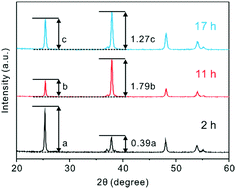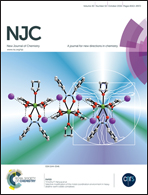Preparation of anatase TiO2 nanotube arrays dominated by highly reactive facets via anodization for high photocatalytic performances†
Abstract
Well-defined uniform anatase TiO2 nanotube (TNT) arrays with predominant exposure of the highly energetic {001} facets have been prepared via a two-step anodic oxidation process of Ti foil. In order to enhance the exposure degree of the {001} facets, NH4F has been used as a capping agent during anodization and the evolution of TNT arrays has been varied by changing the duration of anodization and the concentration of NH4F. With the increase of the first-anodization time (up to 11 h) and/or the NH4F concentration, the crystallite sizes, crystallinity, and exposed {001} facets of prepared TNT arrays have been found to increase. The photocatalytic activity of the as-prepared TNT arrays, evaluated by monitoring the photodegradation of rhodamine B, has been found to increase in accordance with an increase in the exposure degree of the {001} facets, indicating that the highly energetic {001} facets enhance the photocatalytic activity of TNT arrays on a large scale. The {001} facets of TNT arrays have been considered to provide oxidation sites extensively, which produce active oxygen species such as ˙OH, ˙O2−, and H2O2 upon UV irradiation. Our results have shown that ˙OH is the predominant highly active species for the photocatalytic degradation of organic dye pollutants via TNT arrays. We consider that this study may provide a new insight into the preparation and development of advanced photocatalytic anatase TiO2 materials.


 Please wait while we load your content...
Please wait while we load your content...